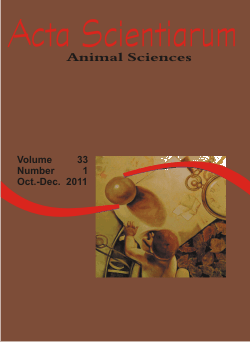<b>Effects of lineage and sex on geometrical and biomechanical properties of broiler chickens tibias</b> - doi: 10.4025/actascianimsci.v33i1.8090
Keywords:
sexual dimorphism, mechanical tests, leg problems, bone strength
Abstract
The intensive rearing of broilers, combined with nutrition and genetic improvement focused on weight gain has resulted in increasing rates of leg problems. Among the variables that may contribute to the occurrence of these problems are sex and lineage. In this context, the study evaluated the geometric and mechanical properties of the tibiae of broilers, male and female, from three commercial lines in the final growth stage, between 21 and 42 days. The geometric characteristics reflect the adaptive response of bone, with a direct relationship between their dimensions and the live weight of birds. As for the mechanical properties obtained from bending tests, it is observed that the evaluation of bone strength can lead to different conclusions depending on the mechanical parameter considered. Heavier birds, with larger bones, support more load in bending. However, when intrinsic strength parameters of the material are considered, such as bending strength, it is observed that the heavier line does not show significantly different values from the others. The same occurred among males (heavier) and females. Thus, heavier birds may be more susceptible to structural leg problems, as their tibias are as strong as those from lighter birds.Downloads
Download data is not yet available.
Published
2011-02-03
How to Cite
Reis, D. T. da C., Torres, R. de A., Barbosa, A. de A., Rodrigues, C. de S., & Moraes, G. H. K. de. (2011). <b>Effects of lineage and sex on geometrical and biomechanical properties of broiler chickens tibias</b> - doi: 10.4025/actascianimsci.v33i1.8090. Acta Scientiarum. Animal Sciences, 33(1), 101-108. https://doi.org/10.4025/actascianimsci.v33i1.8090
Issue
Section
Animal Breeding and Reproduction
DECLARATION OF ORIGINALITY AND COPYRIGHTS
- I Declare that current article is original and has not been submitted for publication, in part or in whole, to any other national or international journal.
The copyrights belong exclusively to the authors. Published content is licensed under Creative Commons Attribution 4.0 (CC BY 4.0) guidelines, which allows sharing (copy and distribution of the material in any medium or format) and adaptation (remix, transform, and build upon the material) for any purpose, even commercially, under the terms of attribution.
Read this link for further information on how to use CC BY 4.0 properly.
0.9
2019CiteScore
29th percentile
Powered by 








































